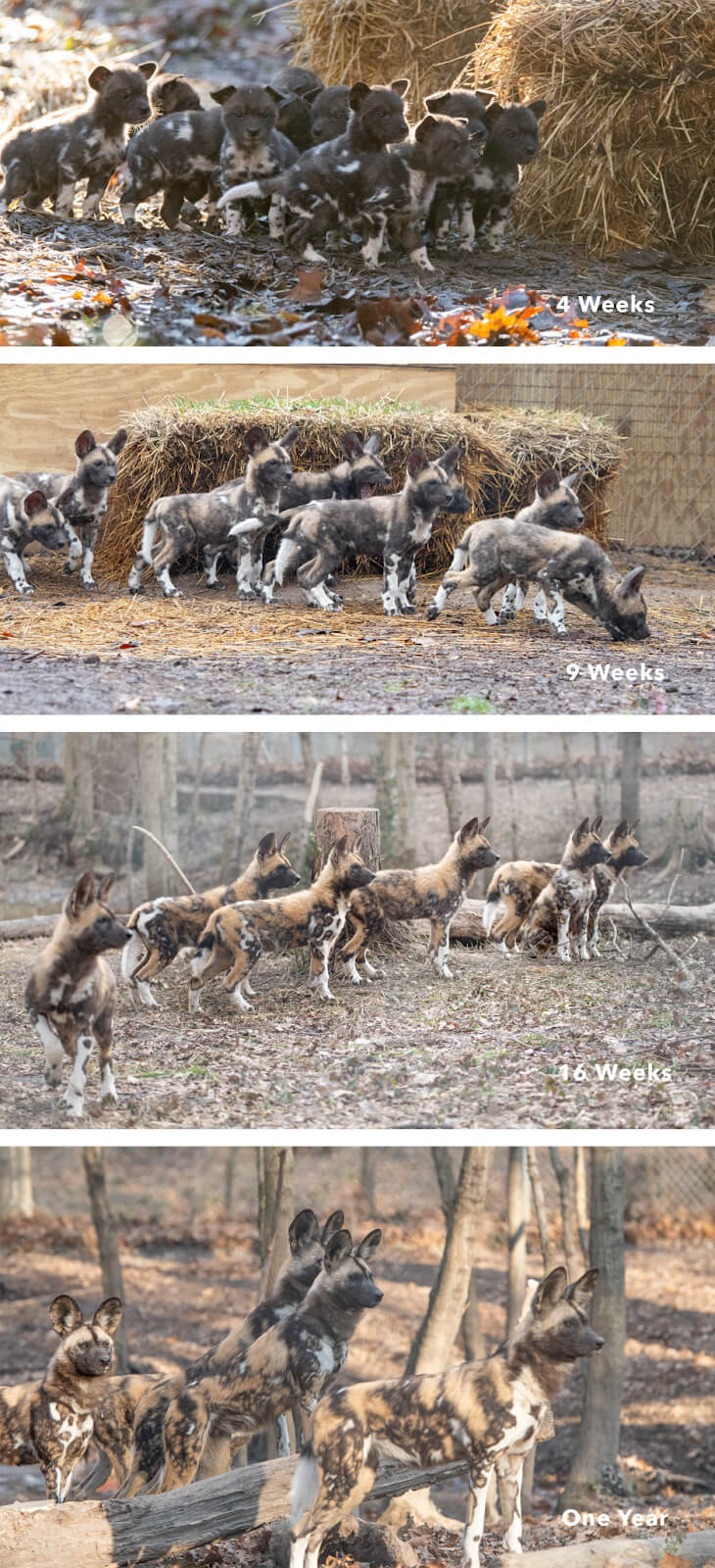
African painted dog pups from one month to one year.
Their antics charmed our visitors and over the past three years, we’ve watched them grow into incredible adults, and some have moved to other facilities to start families of their own.
Their time here at the Endangered Wolf Center offered us a unique opportunity to conduct research, and the findings from the study were recently published. Why was this such a special opportunity?
Large Litters from Two Sisters
Mother Shaba gave birth to 13 pups and her sister, Akili, gave birth to 11 pups. It is unusual for two females in the same pack to give birth at the same time and have all of the pups from both litters survive.
In fact, it has only happened once in the United States in almost 90 years of painted dogs in zoological institutions in the United States.
“Even though it is incredibly rare, we knew it was a possibility so we [EWC] planned and prepared extensively for it, just in case…but we honestly didn’t think it could happen,” said Regina Mossotti, our director of animal care and conservation.
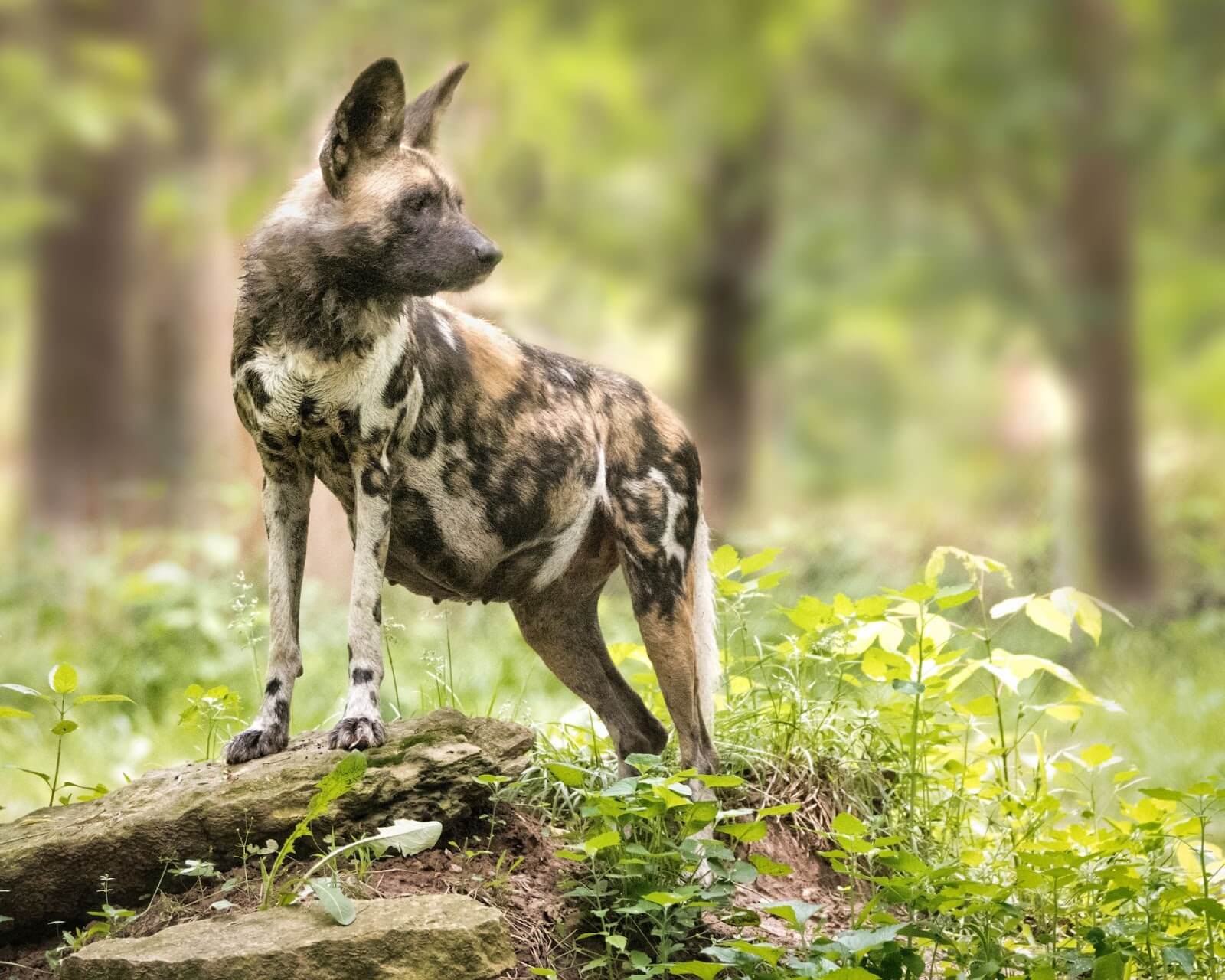
Expectant mother, Akili, poses for her maternity photo.
Mossotti also sits on the management team for the African Painted Dog Species Survival Plan (APDSSP). The Species Survival Plan (SSP) helps manage the genetics and care of the population for this endangered species at more than 25 zoos across the United States.
A Fascinating Animal in the African Landscape
African painted dogs are unique in many ways in the Canidae family (canids, relatives in the dog family, such as wolves, foxes, etc.). One example is that they have exceptionally large litter sizes. African painted dogs’ average litter size is 10 pups. To put this in perspective, wolves have an average of four to five pups in a litter. To accommodate these large litters, the painted dog mothers have an extra set of nipples (10 in all) to help feed the large litters.
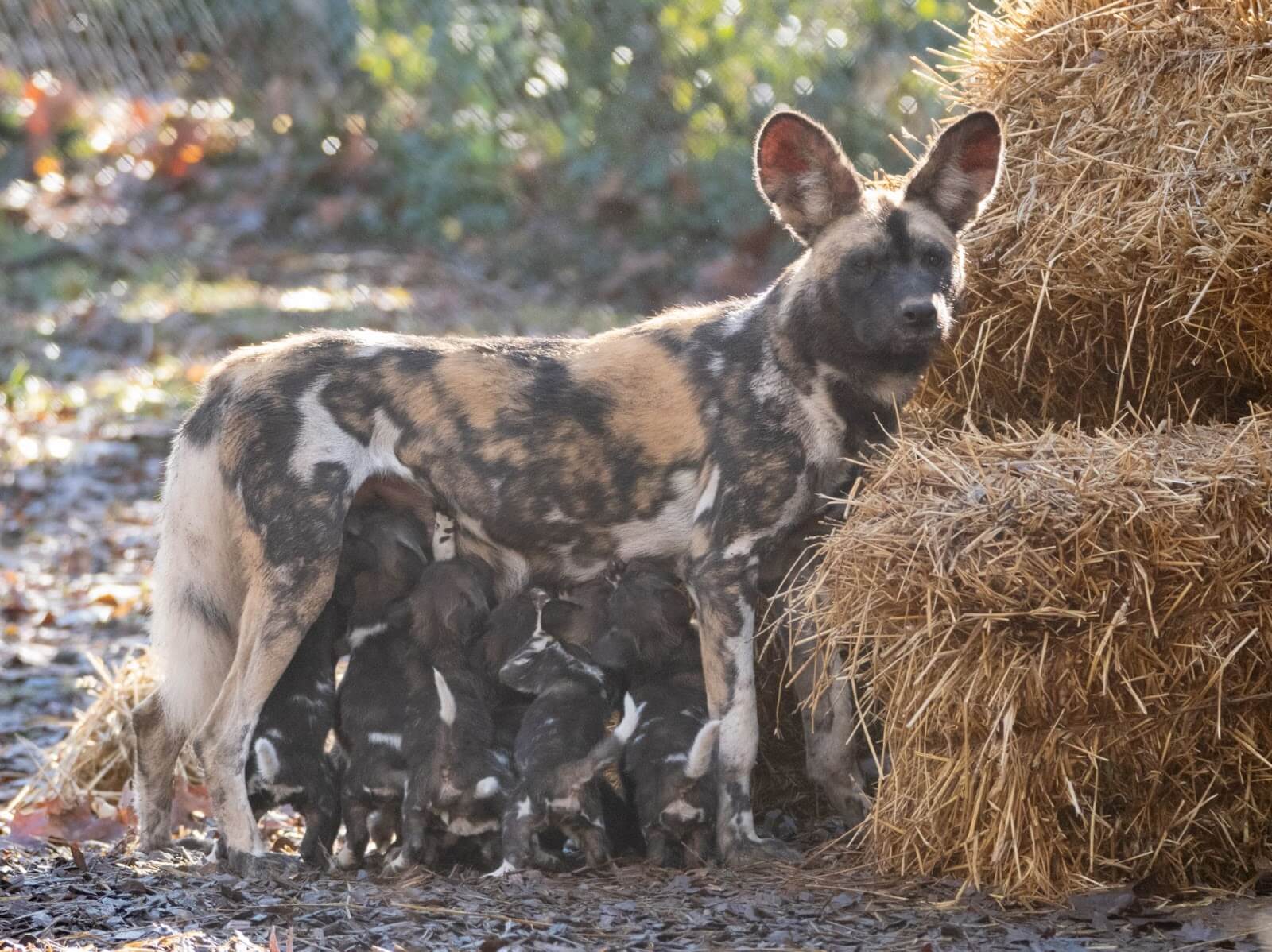
New mother, Shaba, nurses her pups outside the entrance of her den.
Evolutionarily, it makes sense why the litters are large. In Africa, painted dog packs have many challenges, including other large carnivores that may kill members of the pack (lion, hyena, leopard, cheetah, etc.), injuries during the hunt, diseases, and human-caused mortality. Large litters help ensure that some survive to adulthood to help the pack carry on their genetics, but these large litters also help make sure the pack is more successful at hunting. African painted dogs are the most successful hunters in the canid family (60-80% success rate, compared to 10% success rate of wolves).
Preparing for Pups
The EWC did an excellent job preparing the painted dog habitats and dens, making sure they were warm and safe, providing great nutrition for the mothers, conducting round the clock observations during labor and for weeks after the births to ensure the mothers and pups were thriving. Haka, the father of both litters, was also attentive to both mothers and helped care for both litters.
Shaba went into labor first on November 16, 2018 and was calm and attentive to the pups. She had 13 pups and kept them all alive, clean and well fed. Akili was nervous when her sister went into labor. She and Shaba are very close and spent a lot of time together before the pups were born. Painted dogs in a pack seem to have a very tight bond and a “one for all, all for one” social structure. However, Akili went into labor herself and four days later gave birth to her own litter of 11 pups. One pup was stillborn, but the remaining 10 pups were healthy. Like her sister, she kept all 10 of her pups alive, healthy and well fed. For Shaba and Akili, these were their first successful litters, and they quickly became remarkable mothers.
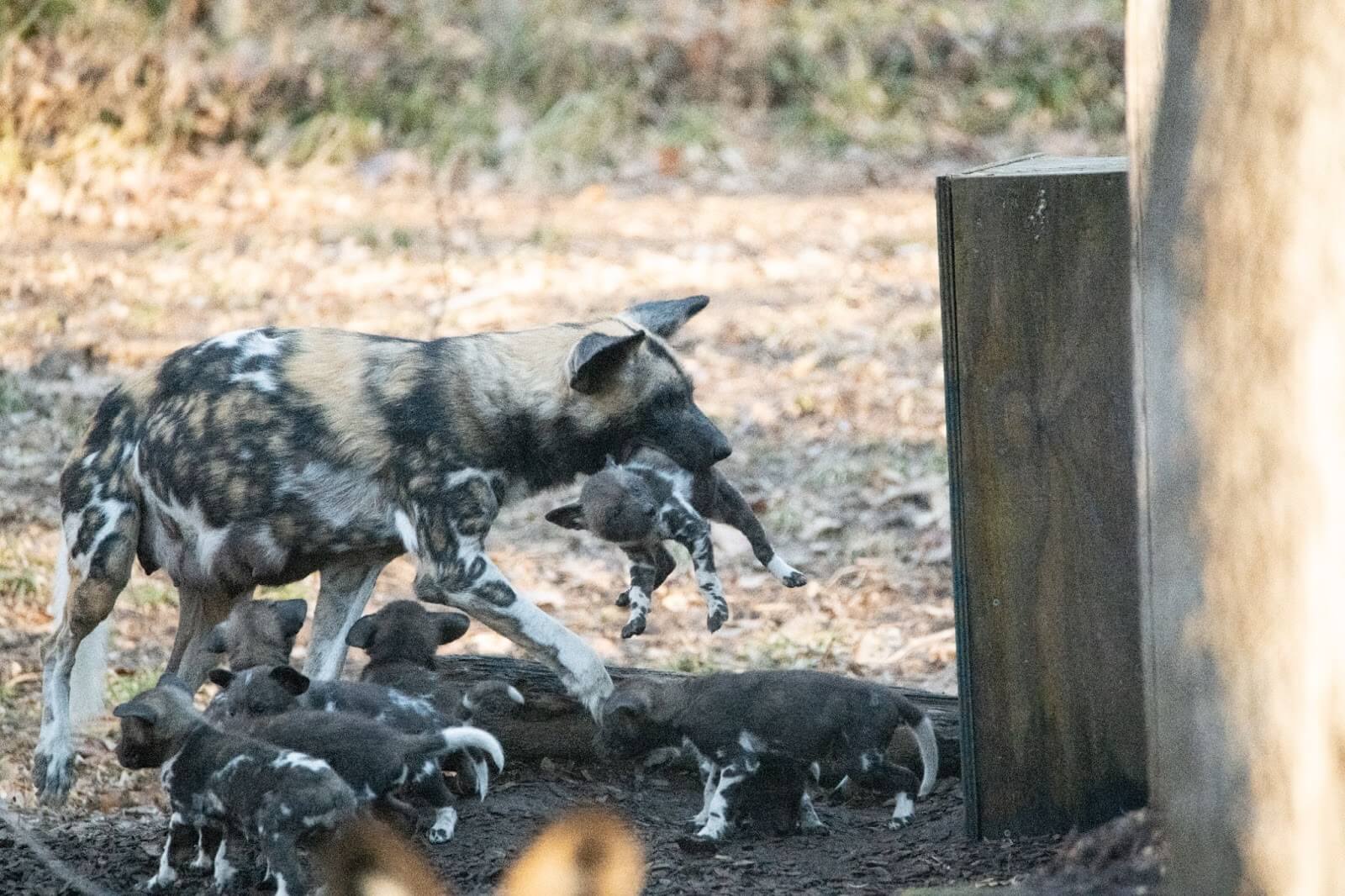
Shaba and Akili became remarkable mothers to their large litters..
The EWC was able to share this experience with the public on our live webcams, and we had hundreds of thousands of views from people all over the world. This learning opportunity helped to show the beautiful nurturing side of this endangered species and teach about their plight in the wild.
In spite of their close relationship, the sisters had to be separated during their labors. We had hoped that we would be able to put the mothers with their pups back together, but when this was attempted they showed increased protectiveness of their litters from each other. We decided to keep the mothers separate to give their pups the best chance of survival. Haka spent time with both litters and was able to travel between the two habitats. He was an amazing father, regurgitating to both mothers while they were nursing, and once the pups were old enough, he would bring them food as well. He was patient, caring, and playful with the pups but disciplined them when they would get a little unruly.
Research is a Crucial Aspect of the EWC’s Mission
Mossotti saw a unique opportunity with the two litters to study how diet could affect their leg length and overall growth of African painted dog pups. She had learned from fellow researcher Dr. Gregory Rasmussen that his observations in Zimbabwe showed that wild dogs and dogs in managed care looked slightly different. His theory was that we feed our pups/packs differently than they are fed in the wild. The separation of the pack here at the EWC gave us the opportunity to feed one litter a typical, controlled zoo diet and one litter could be free fed as much food as they could eat until six months old to mimic wild pups’ diets. This free-fed diet was based on observations of how wild packs fed their pups…essentially they fed them constantly.
Mossotti reached out to Tammy Cloutier, then a Ph.D. candidate at Antioch University and painted dog researcher, to collaborate on this research effort. Cloutier, Mossotti, Curator Erin Connett and the entire Endangered Wolf Center Animal Care team collected data and added it to Cloutier’s research to compare growth of painted dogs raised under human care with nutritional conditions enforced versus mimicking wild nutritional patterns.
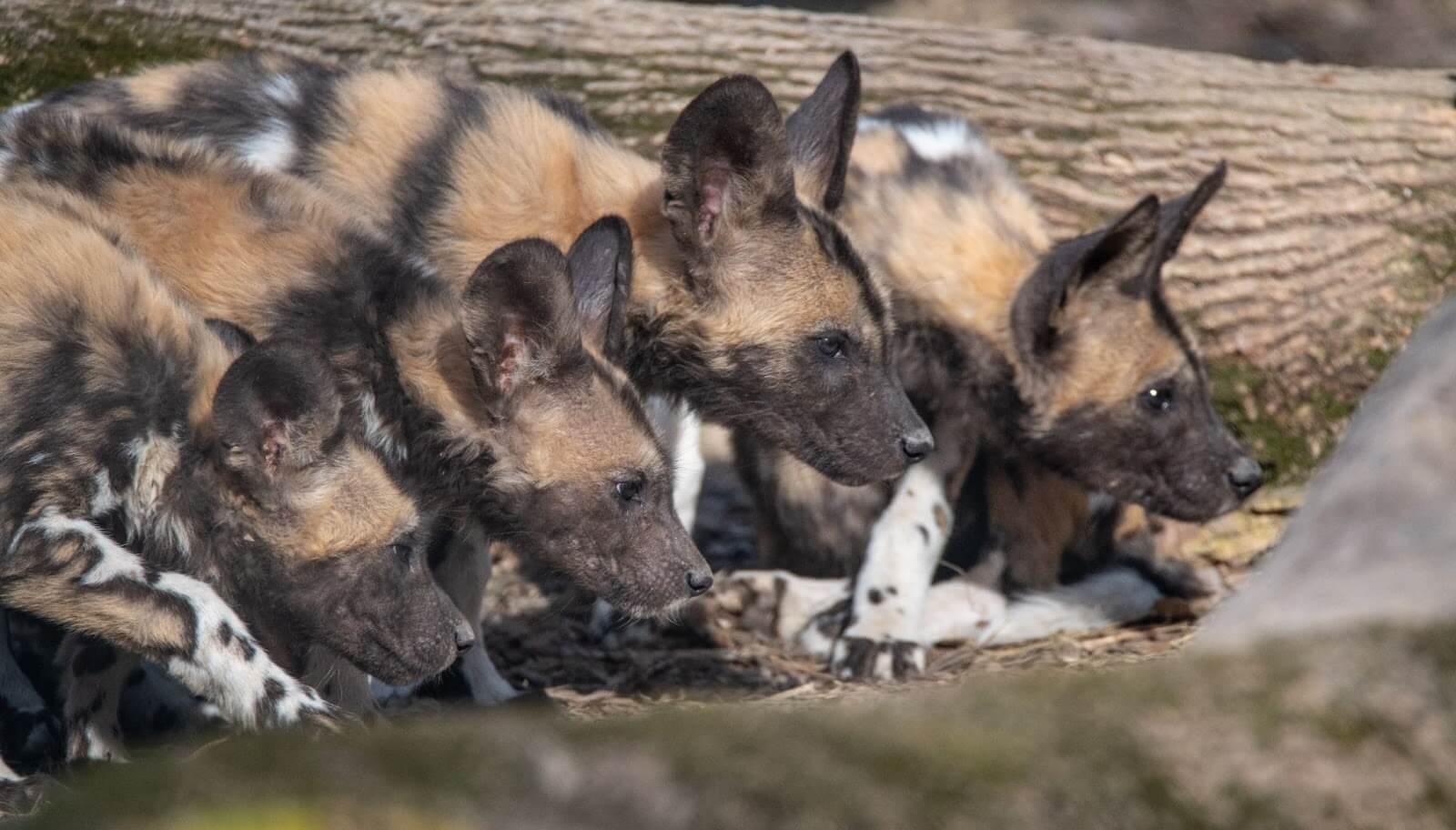
This research has important implications both for in situ (wild) and ex situ (captive) management and conservation of African painted dogs. In managed care, we strive to provide the best welfare to our animals across the zoological community, and we want to ensure that we use the species’ natural history to guide our animal care protocols. To base these protocols on sound science that takes in the needs of the wild and managed care dogs is vital to the SSP’s success. This research can also help wildlife management decisions in the wilds of Africa. Learning the nutritional and caloric needs of the wild pups can help wildlife managers protect and manage the dwindling wild populations of African painted dogs ensuring they get what they need to survive and (hopefully) increase their numbers in the wild. This is why research is a vital part of the EWC’s mission.
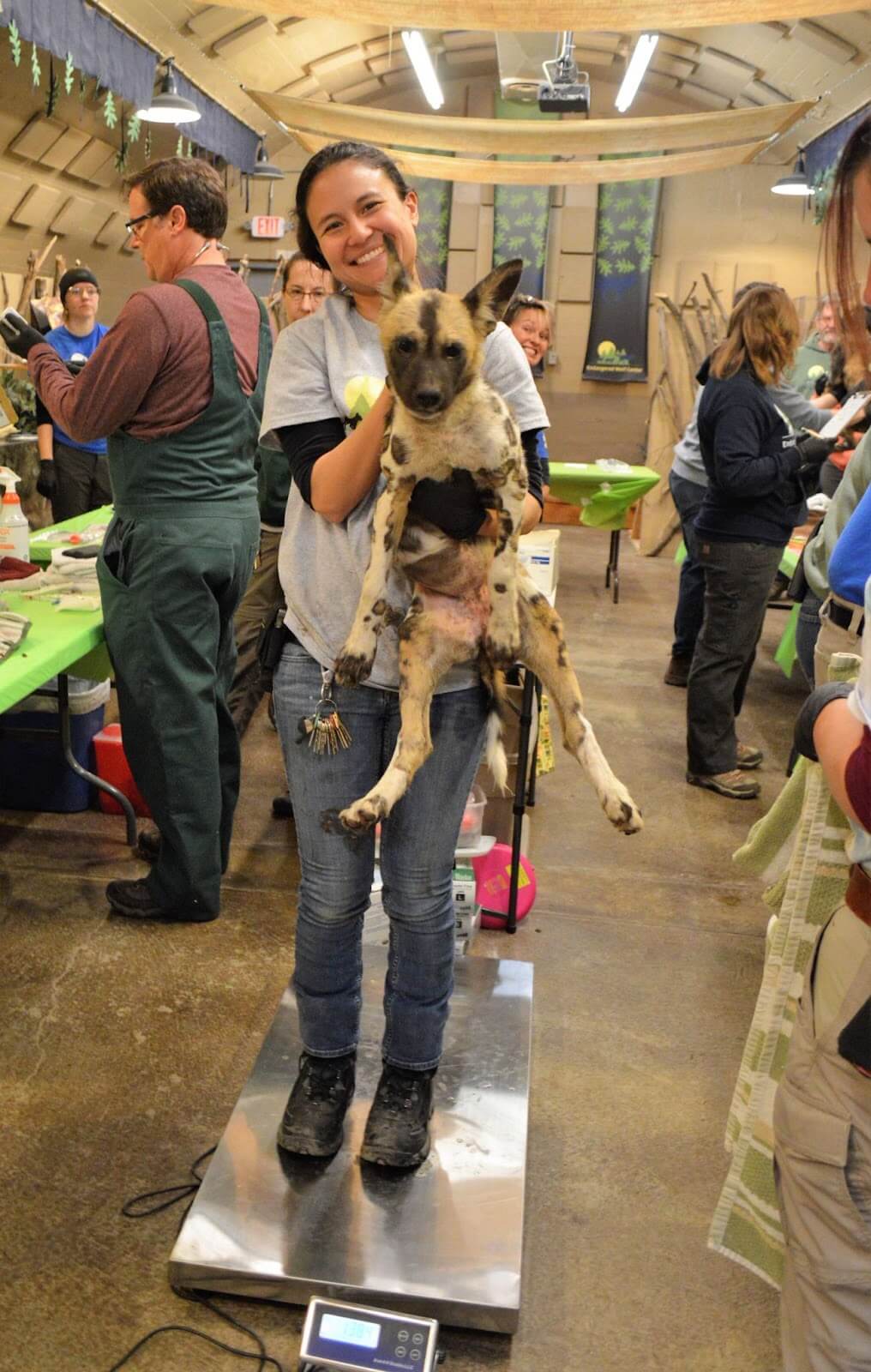
Keeper Sarah Holaday weighs an African painted dog on the scale during a veterinary exam.
“The more we know about and understand a species, the better equipped we are to save them, to make conservation and management decisions that are thoughtful and effective,” says Mossotti.
The EWC’s supporters stepped up to help fund this vital research because feeding 26 painted dogs is expensive and required a lot of staff time. “It is like feeding 26 of your family members steak dinners three times a day,” said Erin Connett, former EWC general curator.
Erin was instrumental in implementing the logistical needs for this research, as well as managing the staff and intern observations.
The pups at the Endangered Wolf Center, regardless of species, receive health checks and vaccinations at around six nine, 12 and 16 weeks of age.
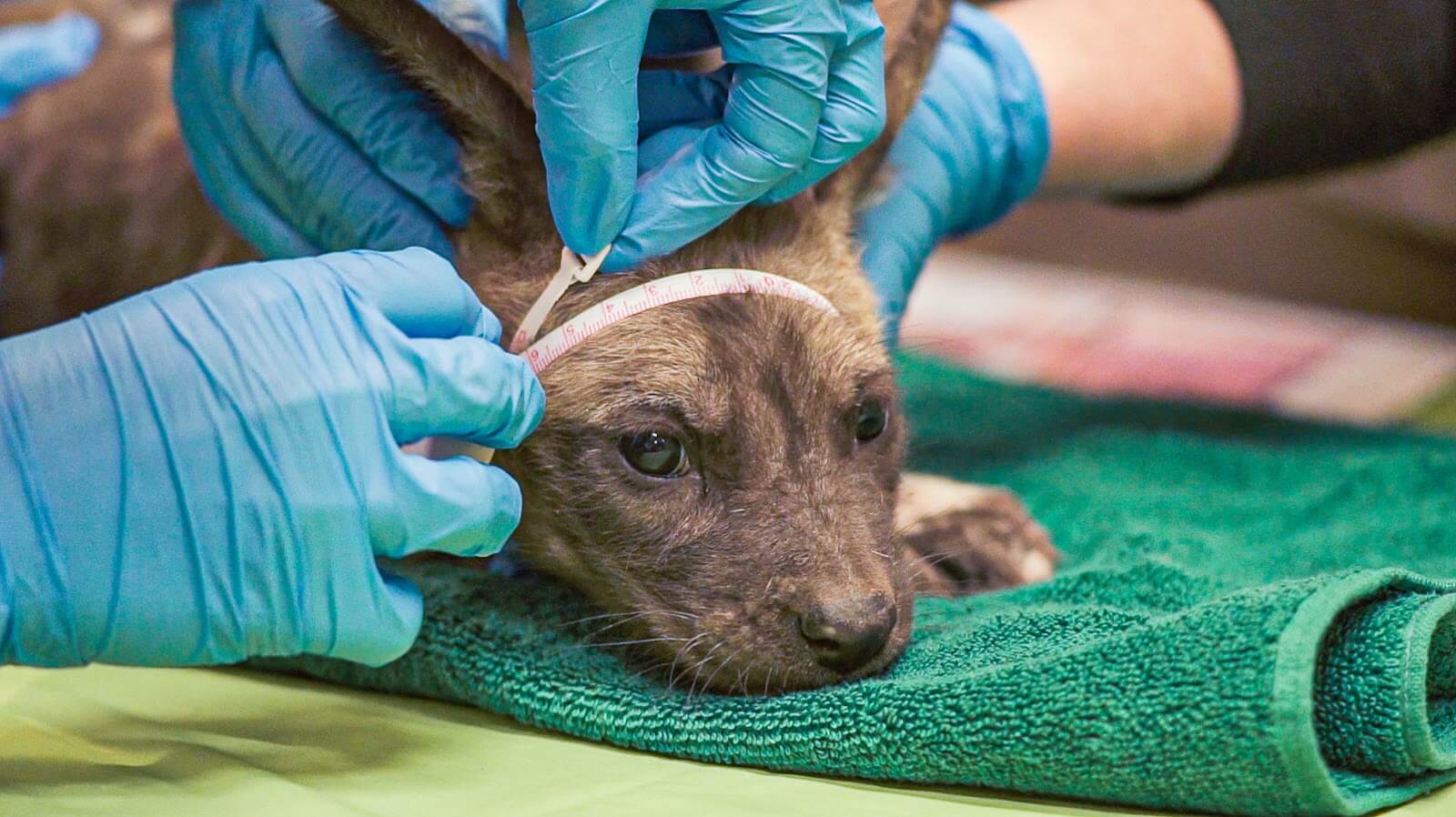
Measurements were carefully taken throughout the study, as the pups grew.
Just like domestic dog pups, vaccinations at this age help ensure they have the best chance at survival. We collaborated with the Saint Louis Zoo veterinary team, Dr. Dan Frasier, Dr. Rhiannon McKnight, Dr. Tammy Smith and Washington University researchers, as well as our staff, interns and volunteers to assist with the exams so they went quickly and smoothly. We took the last measurement of the pups at their six-month exam, the estimated time where major growth stops.
What Did We Learn?
Cloutier has analyzed the data and the research has been published and can be found in the Journal of Zoo and Aquarium Research.
From this research, we discovered that growth measurements between the two litters were comparable for body length, ear height, head circumference, and muzzle length at each age. However, leg and body lengths, and average body mass differed significantly between litters at each age.“One litter had access to food twice per day (once in the morning and once in the afternoon), and the other litter had access to food all day. The litters grew/developed differently. The litter with access to food twice per day had longer hind legs relative to the rest of their body compared to the litter that had access to food all day. This is significant because if pups do not grow properly, it may affect how they move, hunt, etc. when they’re adults – which may affect their survival. While we were only able to collect this information on these two litters, it highlights the importance of learning more about painted dog growth and development for both wild populations and individuals under human care.”
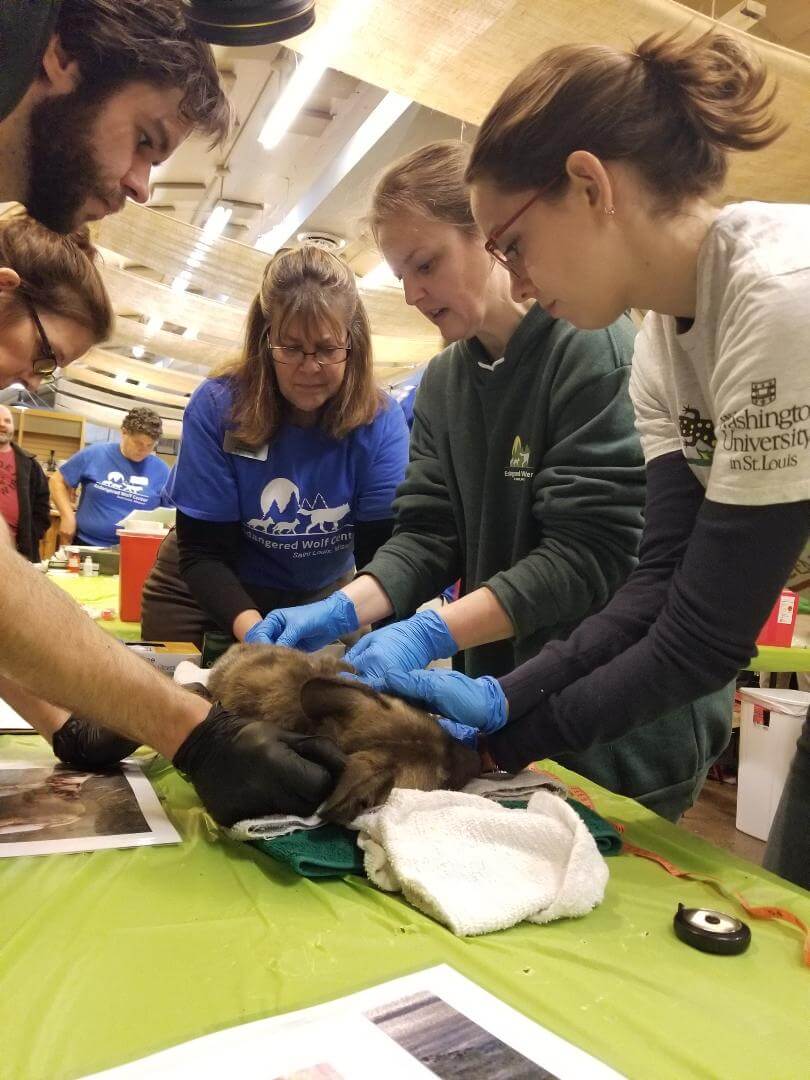
Volunteers and collaborators assist in taking measurements during the veterinary exams.
Although limited by the fact that we could only look at these two litters, the findings of our opportunistic study indicate that the relationships among feeding frequency, food items, and growth/development require further research, as altered physical characteristics may have consequences for individuals and packs alike.
Their body development can be essential to their success later in life.
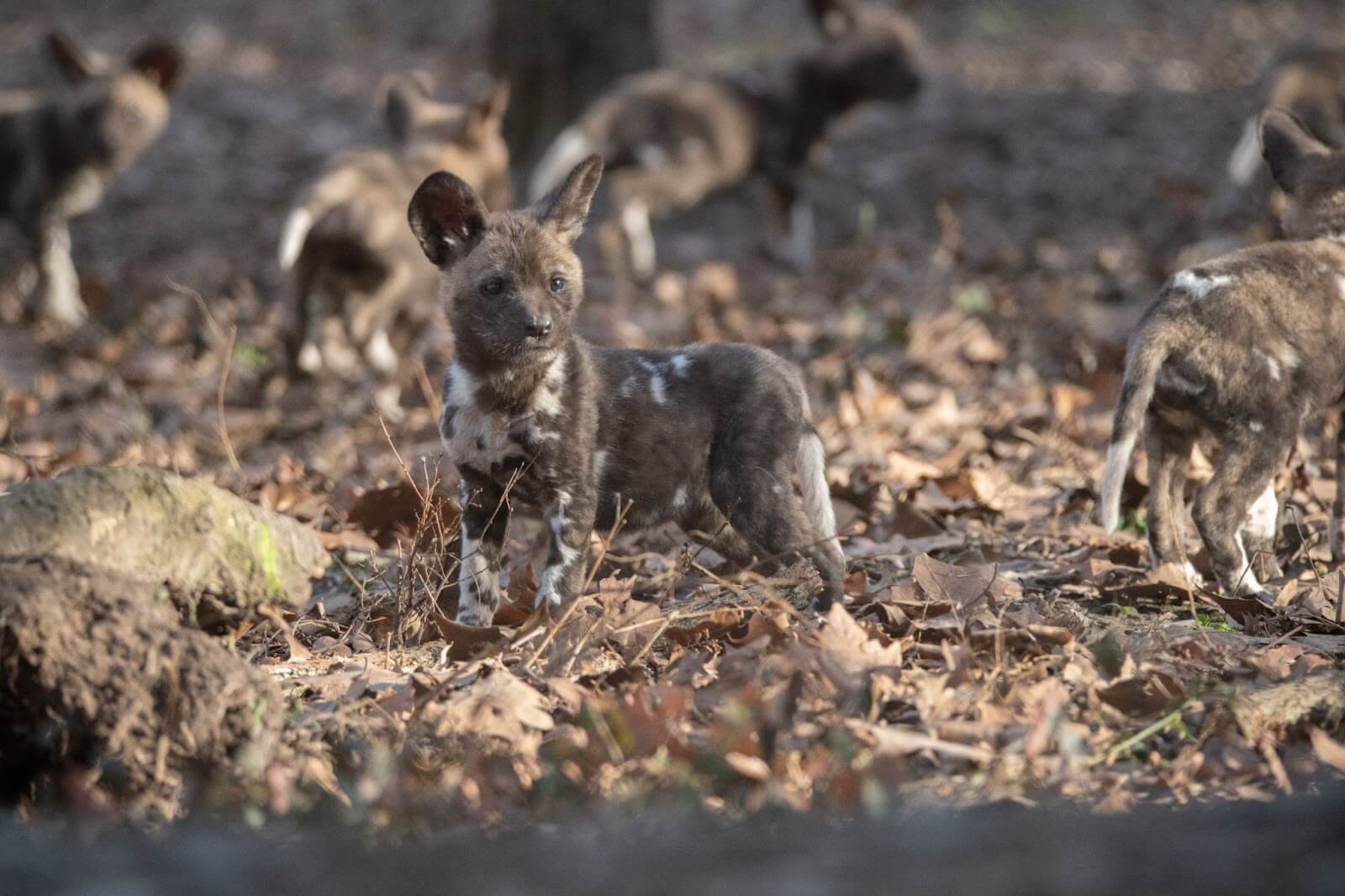
“We still have a lot to learn about painted dogs – both free ranging populations and those under human care. During my PhD program I came across little published literature relating to painted dog growth and development, so I was excited to work with the EWC team when the unique opportunity of two closely related litters presented itself.” -Tammy Cloutier Ph.D.
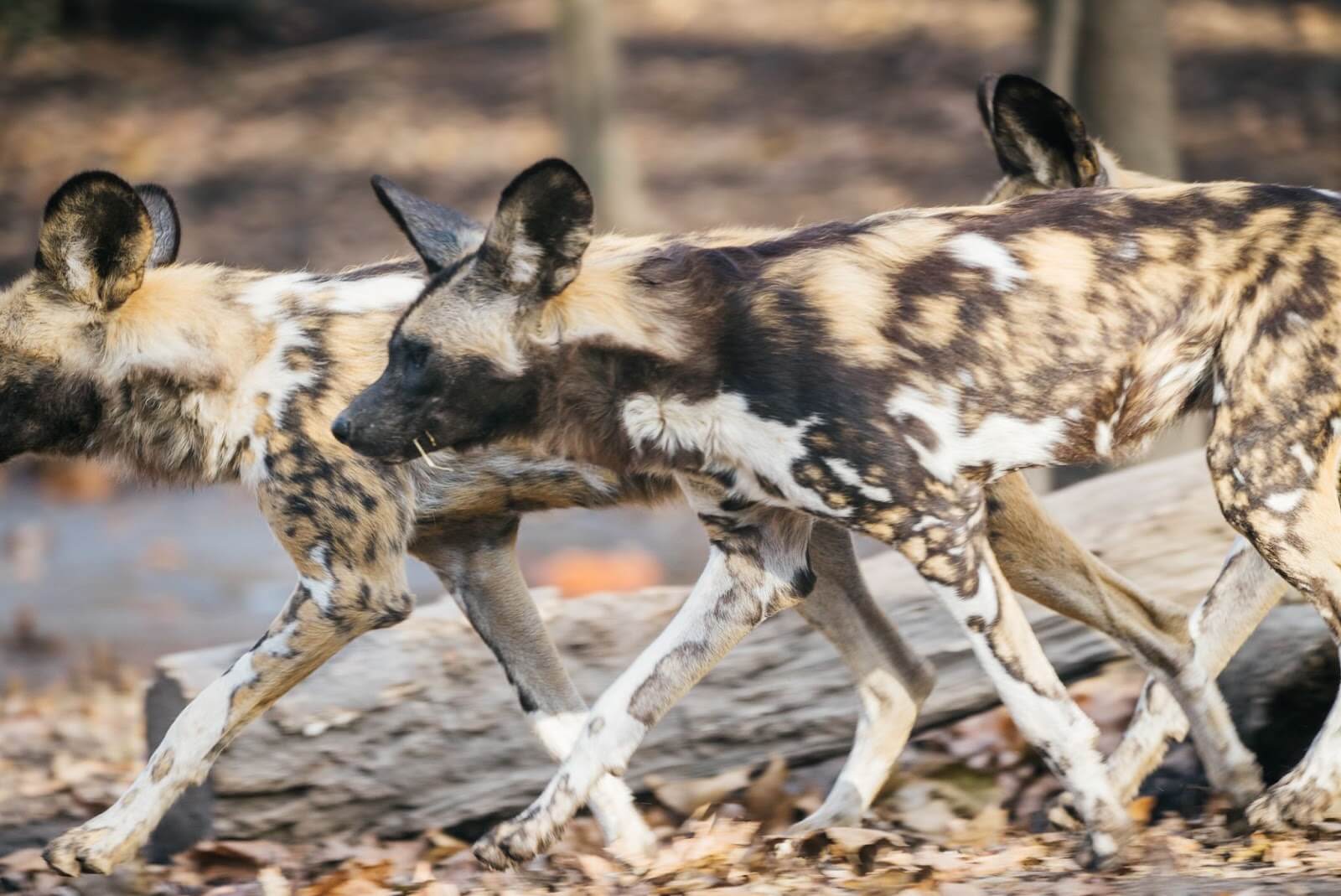
“The collaboration, support, and opportunity to continue to learn how we can best care for painted dogs and other species under our care. Although we were only able to provide a snapshot of what growth and development looked like for the two litters at EWC, and ended up with more questions than answers, it was fun and interesting." -Tammy Cloutier Ph.D.
Leading the Pack Through Research
This was an incredible moment added to the EWC’s rich history. I am proud of our staff for stepping up and seizing this opportunity to push the limits of knowledge further,” said Virginia Busch, EWC Chief Strategist. “The work that went into the research and the world class care of our animals is what makes the Endangered Wolf Center so special. The Center’s dedication, passion and expertise is how we continue to make significant impacts in canid conservation.”
Once the pups reached six months old, Akili and her 10 pups moved to their new home at Cincinnati Zoo because 26 animals in one divided habitat was overwhelming the environment as the pups grew to adult size. Cincinnati Zoo, an APD SSP partner, is also home to African Painted Dog SSP Coordinator, Christina Gorsuch, who will help manage and care for this pack. We could not have asked for a better home for our painted dog family.
Love Painted Dogs? Adopt Our Pack!
You can help painted dog conservation and the efforts of the Endangered Wolf Center by donating to the EWC, symbolically adopting the African painted dog pack and sharing their story with your friends and families.
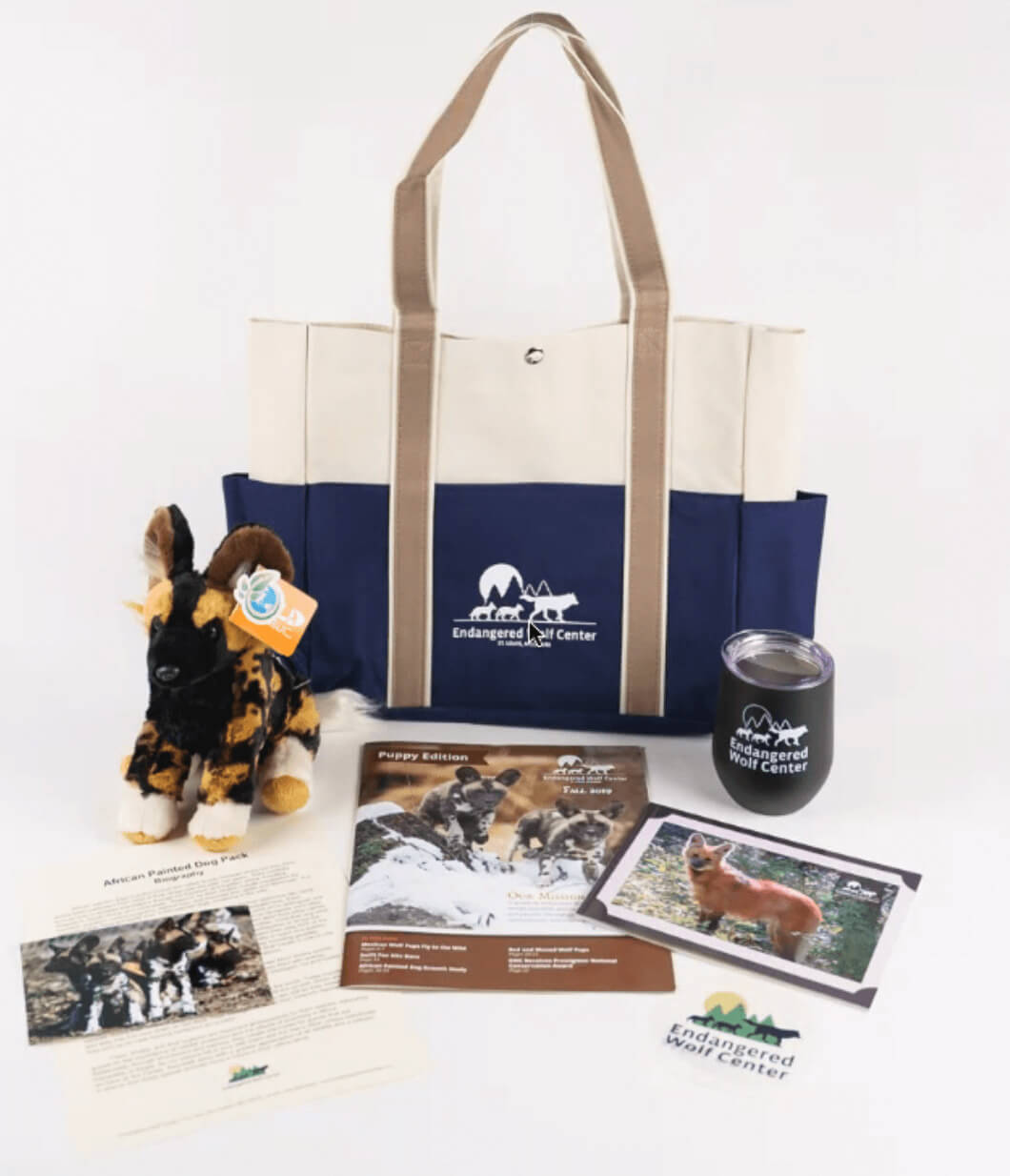
Adopt African Painted Dogs